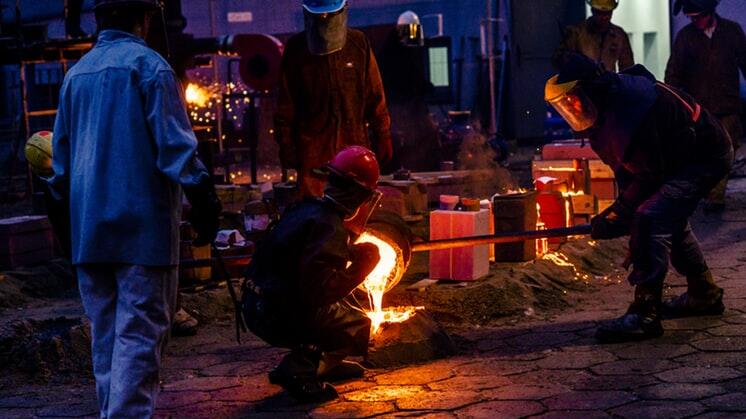 Policy & Regulation
Policy & RegulationEurope’s steel industry and the need to decarbonise
Summary
Europes steel industry needs a credible plan to go green, says Ben Jones. The costs of decarbonising its operations would cost up to €40bn. Jones raises a question whether consumers will be demanding greener steel and be willing to pay for it. European Commission is planning to level the playing field by imposing a tariff on carbon embodied in imported steel. There is a delicate balancing act for the interest of both consumers and producers. And there is more going on to promote industrial energy efficiency in Europe. The Energy Efficiency Financial Institutions Group (EEFIG) recently held its first Working Group meeting. This group will assess the industrial practices dealing with energy efficiency, will identify and assess the main obstacles and drivers for improving energy efficiency within energy-intensive industries, and will provide recommendations to DG ENERGY on what tools and policy instruments are likely to be most effective for increasing the energy efficiency investments in industry. And the European Commission has also been supporting projects.
Open full article
Europe’s steel industry and the need to decarbonise
A recent article by Ben Jones in the Financial Times (Europe’s steel industry needs a credible plan to go green, August 6, 2020) discussed the problems that the steel industry is having in reducing its carbon footprint. The costs were prohibitive. ArcelorMittal , Europe’s biggest steel maker, warned that decarbonising its operations would cost up to €40bn. There are calls for public support. As Jones explains, the level of capital expenditure is beyond an industry struggling with narrow margins and heavy debts. He goes on to say that “a shift to low carbon technologies would likely require a carbon price today of at least $100 per tonne of C02 to foster a shift to low carbon steel making technologies.”
Jones raises a question whether consumers will be demanding “greener” steel and be willing to pay for it. At this point there is no market for low-carbon products and low-carbon products are often sold into a manufacturing product chain or embedded into products. This all makes it complicated to say the least.
What is the role of government? Subsidies are needed in some form. Jones also points out that the European Commission now planning to “level the playing field” by imposing a tariff on carbon embodied in imported steel. Undoubtedly, there is a delicate balancing act for the interest of both consumers and producers.
EUROFER, the association that represents the European steel industry, came out in February with its own position on decarbonising and what it needed from policymakers. Concerning financing it stated: “EU steel producers face not only the compliance costs of the EU ETS (€25per tonne of CO2 in October2019), but the full abatement costs. These costs can be more than ten times the current compliance cost per tonne of CO2 abated. Steel markets will not tolerate respective cost pass-through and therefore an overall legal framework needs to address both issues.”
No doubt there will be some hard choices but there is no choice that decarbonisation needs to continue.
There are some initiatives that will help.
In March 2020, the Commission published its industrial strategy. There will be “comprehensive measures to modernise and decarbonise energy-intensive industries, support sustainable and smart mobility industries, to promote energy efficiency, strengthen current carbon leakage tools and secure a sufficient and constant supply of low-carbon energy at competitive prices.” The strategy includes a dedicated strategy for small and medium-sized enterprises (SMEs) aims to reduce red tape and help Europe's numerous SMEs to do business across the single market and beyond, access financing and help lead the way on the digital and green transitions.
There is more going on to promote industrial energy efficiency in Europe. The Energy Efficiency Financial Institutions Group (EEFIG) recently held its first Working Group meeting on Industry with me as team lead. Working over the next couple of years, this working group will assess the industrial practices dealing with energy efficiency, will identify and assess the main obstacles and drivers for improving energy efficiency in industry, will identify best practices, and will provide recommendations to DG ENERGY on what tools and policy instruments are likely to be most effective for increasing the energy efficiency investments in industry. The Working Group will be addressing various aspects of energy efficiency within energy-intensive industries and industrial SMEs and non-energy-intensive industries. Importantly, this group will energise stakeholders.
The European Commission has also been supporting projects to test out new technologies and techniques to improve energy performance. RETROFEED is but one example. It provides an interesting package. RETROFEED’s main objective is to enable the use of an increasingly variable, bio-based and circular feedstock in process industries through the retrofitting of core equipment and the implementation of an advanced monitoring and control system, and providing support to the plant operators by means of a DSS – Decision Support System – covering the production chain. There will be significant investment to test the system in different industrial sub-sectors. Importantly, two of the six demonstration sites are in the steel sector.
For more information on RETROFEED, please contact:
- Dr Ana Isabel Gonzalez Espinosa (CIRCE – RETROFEED Project Coordinator) aigonzalez(at)fcirce.es
- Dr Diego Redondo Taberner (CIRCE – RETROFEED Project Manager) dredondo(at)fcirce.es
- Ms Marianna Santavenere (EEIP – RETROFEED Communication and Dissemination) marianna.santavenere(at)ee-ip.org



